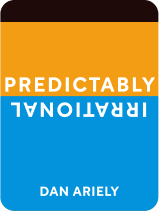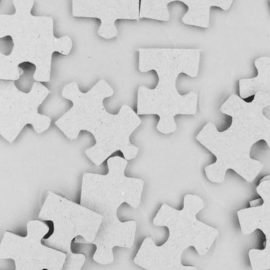

This article is an excerpt from the Shortform book guide to "Predictably Irrational" by Dan Ariely. Shortform has the world's best summaries and analyses of books you should be reading.
Like this article? Sign up for a free trial here .
What is the decoy effect? How are we manipulated into making decisions without even knowing it? How can you use the decoy effect to your advantage?
The decoy effect is when you’re presented with options, including an obviously unfavorable option, to trigger a comparison that will guide you towards a certain choice. Marketing agencies, subscription services, and even real estate agents use this technique.
Continue on to learn more about the decoy effect.
The Decoy Effect
Marketing agencies and salespeople understand that people naturally make comparisons, as a sort of decision weathervane. Subsequently, their advertisements and tactics are often framed to force you into making comparisons and drawing conclusions that are beneficial for them, not you.
Many advertisers utilize the decoy effect. They present you with options, including a clearly unfavorable option—the “decoy”—to trigger a comparison that will guide you toward a specific choice.
Imagine that you see an advertisement for National Geographic subscription bundles. There are three options:
- Internet only: $59/year
- Print only: $125/year
- Internet and print: $125/year
The print-only option is the decoy—you’ll likely conclude that it’s a rip-off, because it makes no sense to pay $125 for just print when you could have the internet and print bundle for the same exact price. Furthermore, because the print-only price and the bundle price are the same, it seems that the bundle offers the internet subscription for free. Just as the advertisers planned, you’re thinking that the bundle is a very good deal.
It’s likely this is an irrational choice for you. Is it really necessary to have two media options? Perhaps you prefer to read print copies of magazines, or only intend to use the internet portion of your subscription. But, as it feels like the “right” choice compared to the other two, you’ll almost certainly choose the bundle.
Experiment: Magazine Subscriptions
For further proof of how drastically “decoys” can disrupt rational decision-making, consider the following experiment at MIT. In the first part of the experiment, the three subscription choices were presented to 100 students. As predicted, their choices were:
- 16 students: Internet only for $59
- 0 students: Print only for $125
- 84 students: print and internet for $125
In the second part of the experiment, the decoy was removed. Rationally, their choices should be exactly the same as in the first part, because the only option that was removed was the option that 0 students chose. Instead, the students responded as such:
- 68 students (up from 16): internet only for $59
- 32 students (down from 84): print and internet for $125.
The majority of students chose the internet-only option. This makes sense—the internet-only option is far cheaper, and university students are likely to only use the internet. This tells us that without the inclusion of an unfavorable decoy, we have a much greater capability to make rational decisions that suit our needs and preferences.
The Middle-Of-the-Road Decoy
At times, the decoy effect won’t be so obvious and there won’t be a clearly unfavorable option present. In these cases, you’ll look for information that can nudge you toward an option that feels safe or correct. Salespeople use this to their advantage, setting up options that act like gutter guards on the sides of a bowling alley, keeping you on a straight path toward the “middle” option they’ve already chosen for you.
This tactic can be hard to spot. Imagine that you’re shopping for a new television and you see three TVs set up together at the store:
- 36-inch Samsung for $500
- 48-inch LG for $825
- 60-inch Sharp for $1,560
As a customer, you’re unlikely to research how Samsung, LG, and Sharp measure up against one another and if the advertised prices are a decent deal or not. Instead, you’ll probably use the highest and lowest prices and biggest and smallest screens as comparative guidelines—and choose whatever’s in the middle. Your TV salesperson knows this, and prices his televisions and sets them up side by side to encourage this very thought process. In doing so, he guides you to the LG television (which likely turns him the largest profit).
This tactic could also look like a restaurant far overpricing something on the menu to maximize their profits. They do this because it’s been shown that restaurant-goers often won’t order the most expensive item on the menu, but they’ll very often order the second-most-expensive item on the menu. Therefore, when restaurants set their prices, they often list a dish that they’re not particularly interested in selling as their most expensive dish and will list a profit-turning dish they do want to sell a few dollars lower.
Beware of Easy Comparisons
One thing that compounds the trickiness of the decoy effect is the way we decide how much effort we’re willing to put into making comparisons. When making comparisons, we tend to focus on comparing things that are similar—therefore more easily comparable—and ignore things that are different and therefore less easily comparable.
Many industries, such as real estate and travel agencies, play into this line of thinking. When you’re deciding between two options (A and B) and their accompanying attributes, you may be presented with a third option (-A), which is similar to—but worse than—one of the options. Because the two “A” options are more easily comparable than A and B, you’ll quickly reject the B option. Then, because the -A option is clearly worse than the A option, A will be your final decision.
Imagine that you’re looking to purchase an apartment. The two most important factors in your search are outdoor space and distance to work. You find two interesting apartments—a split home in the suburbs (A) and a brownstone in center city (B). The suburban option is superior in terms of outdoor space, but the brownstone is much closer to your work.
Your real estate agent then shows you a third apartment (-A): a suburban split home with a lot of outdoor space—but that outdoor space is directly next to busy train tracks.
With the introduction of apartment -A, your real estate agent has essentially made the decision for you. You’ll naturally reject apartment B, because it’s too different from the others, and therefore harder to compare. Then, you’ll choose option A as it’s clearly the better of the two suburban homes.
The Decoy Effect in Travel Agencies
The decoy effect is a common selling tactic in travel agencies. Imagine that you’re planning a trip to Europe, and your travel agent shows you two packages—one for Barcelona and one for Amsterdam. You’re having trouble deciding between the two because they cost the same, and both include flights, a hotel, and breakfast. Both are interesting destinations with much to see and do.
Then, your travel agent presents a third option: another Amsterdam package. It’s the same price as the others and includes flight and hotel, but it doesn’t include breakfast. Now your choice shifts—it’s not just Amsterdam and Barcelona now. It’s Amsterdam (A), Amsterdam without breakfast (-A), and Barcelona (B).
You’ll likely reject Barcelona right away, as it’s different from the others and not easily comparable. Then, because included breakfast is preferable to no breakfast, you’ll choose the Amsterdam (A) package—just as your travel agent planned.
Using Knowledge of the Decoy Effect to Make Better Purchases
The decoy effect is a powerful selling tool, but you can consciously work against it. When making purchases, think about why you’re making the comparisons that you’re making. Are you just looking for a middle-of-the-road price, instead of doing research? Were you presented with options designed to lead you toward a specific choice?
When you’re aware of how the decoy effect is being used to influence your purchases, you can make a rational decision by doing research or by committing to making smart comparisons, even if the two items before you are very different and will take a good deal of mental effort to compare.
The Decoy Effect and Dating
The decoy effect works the same way when you’re comparing people as it does when you’re comparing houses, televisions, or vacation packages. For this reason, it can actually have a heavy influence on who you find attractive or choose to date.
In an experiment at MIT, students were presented with three photographs. Two of the photographs were of person A and person B, both similar in looks and overall attractiveness. The third photograph was of person -A—that is, a slightly distorted image of person A. The students were asked to choose which of the three people they would prefer to date.
75% of the students chose person A. Following the decoy effect, they rejected person B because they were different and therefore not easily comparable, and then realized that person -A was clearly unfavorable compared to person A.
An interesting takeaway here is that you can use the decoy effect to your advantage when it comes to dating. Try going to the bar with a friend who has similar physical characteristics to you, but is slightly less attractive and see how it plays out in your favor.
- First, the people you’re chatting up will focus on you and your friend, as the crowd is full of dissimilar faces that are too difficult to compare.
- Second, when it’s down to you and your decoy friend (-you, in a sense), you’ll be the more attractive choice.
(Of course, don’t tell your friend what you’re up to unless you’re interested in destroying a friendship.)

———End of Preview———
Like what you just read? Read the rest of the world's best book summary and analysis of Dan Ariely's "Predictably Irrational" at Shortform .
Here's what you'll find in our full Predictably Irrational summary :
- How logic is failing you on a daily basis
- How to identify your irrational behaviors
- Why getting something for free can cause you to make bad decisions






